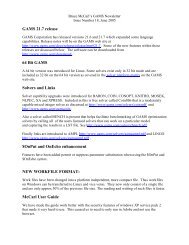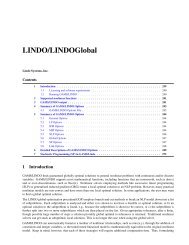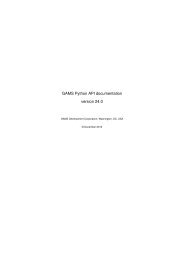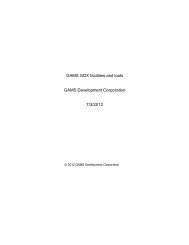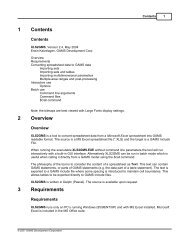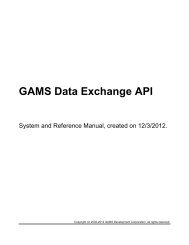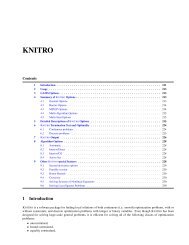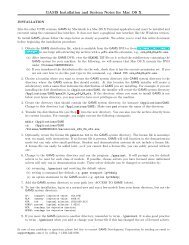Economic Equilibrium Modeling with GAMS
Economic Equilibrium Modeling with GAMS
Economic Equilibrium Modeling with GAMS
Create successful ePaper yourself
Turn your PDF publications into a flip-book with our unique Google optimized e-Paper software.
4<br />
Figure 1. An Indi erence Curve<br />
Y<br />
4<br />
1<br />
1 3<br />
on the preferences of a single consumer, the indi erence curve is a line which connects<br />
all combinations of two goods x and y between which our consumer is indi erent. As<br />
this curve is drawn, we have represented an agent <strong>with</strong> well-behaved preferences: at<br />
any allocation, more is better (monotonicity), and averages are preferred to extremes<br />
(convexity). Exactly one indi erence curve goes through each positive combination of x<br />
and y. Higher indi erence curves lie to the north-east.<br />
If we wish to characterize an agent's preferences, the marginal rate of substitution<br />
(MRS) is a useful point of reference. At a given combination of x and y, the marginal<br />
rate of substitution is the slope of the associated indi erence curve. As drawn, the MRS<br />
increases in magnitude as we move to the northwest and the MRS decreases as we move<br />
to the south east. The intuitive understanding is that the MRS measures the willingness<br />
of the consumer to trade o one good for the other. As the consumer has greater amounts<br />
of x, she will be willing to trade more units of x for each additional unit of y { this results<br />
from convexity.<br />
An ordinal utility function U(x; y) provides a helpful tool for representing preferences.<br />
This is a function which associates a number <strong>with</strong> each indi erence curve. These numbers<br />
increase as we move to the northeast, <strong>with</strong> each successive indi erence curve representing<br />
bundles which are preferred over the last. The particular number assigned to an indi erence<br />
curve has no intrinsic meaning. All we know is that if U(x1;y1) > U(x2;y2), then the<br />
consumer prefers bundle 1 to bundle 2.<br />
Figure 2 illustrates how it is possible to use a utility function to generate a diagram<br />
<strong>with</strong> the associated indi erence curves. This gure illustrates Cobb-Douglas well-behaved<br />
preferences which are commonly employed in applied work.<br />
Up to this point, we have wehave focused exclusively on the characterization of preferences.<br />
Let us now consider the other side of the consumer model { the budget constraint.<br />
The simplest approach tocharacterizing consumer income is to assume that the consumer<br />
has a xed money income which she may spend on any goods. The only constraint on this<br />
choice is that the value of the expenditure may not exceed the money income. This is the<br />
standard budget constraint:<br />
Pxx + Pyy = M:<br />
X



